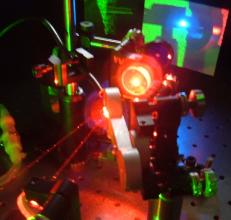Publications
VECSEL papers and reading.
Links
Useful VECSEL, Laser and Semiconductor information.
Access my PhD Thesis
"Mode-Locked Vertical-External-Cavity Surface Emitting Lasers"
|
 My research is in the area of Optically Pumped Semiconductor Vertical-External Cavity Surface-Emitting Lasers (OP-VECSELs).
I studied towards my PhD in mode-locked VECSELs at the University of Southampton in the School of Physics and Astronomy (2002-2006). The work of my PhD focussed on achieving short, sub-picosecond pulses from VECSELs in the Infrared.
I fibre-amplified VECSEL pulses to achieve high powers, and worked extensively on the design and fabrication of a compact, >100GHz ML-VECSEL for optical clocking applications.
My PhD thesis is entitled 'Mode-Locked Vertical-External-Cavity Surface Emitting Lasers' - you can access it via this link.
My research is in the area of Optically Pumped Semiconductor Vertical-External Cavity Surface-Emitting Lasers (OP-VECSELs).
I studied towards my PhD in mode-locked VECSELs at the University of Southampton in the School of Physics and Astronomy (2002-2006). The work of my PhD focussed on achieving short, sub-picosecond pulses from VECSELs in the Infrared.
I fibre-amplified VECSEL pulses to achieve high powers, and worked extensively on the design and fabrication of a compact, >100GHz ML-VECSEL for optical clocking applications.
My PhD thesis is entitled 'Mode-Locked Vertical-External-Cavity Surface Emitting Lasers' - you can access it via this link.
I currently work at the Institute of Photonics at the University of Strathclyde as a Research Fellow, investigating visible VECSELs. My particular focus is on optimisations of
the nonlinear frequency conversion of Red VECSELs into the UV (pictured right), investigating new nonlinear materials, and tuning methods to improve the performance of these devices.
What is a VECSEL?
|